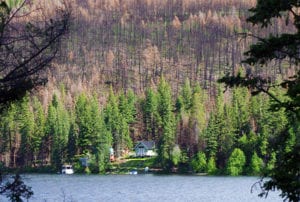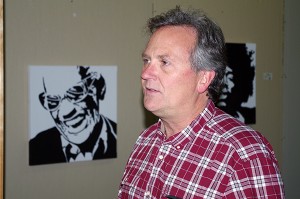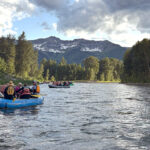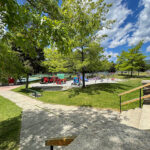Home »

Community Futures fights for businesses impacted by fires
Special Feature
July 6, 2017 will be forever remembered in the Cache Creek/Ashcroft areas of British Columbia as the day everything changed.
In the worst fire season in B.C.’s history, the Elephant Hill wildfire eventually became the biggest of the lot at 191,865 hectares (or roughly 12,000 square kilometres).

The fire prompted evacuations of Cache Creek and area, though Ashcroft residents, with Elephant Hill looming over town, remained on breathless evacuation alert.

On July 18 residents were allowed back to Cache Creek and then the unthinkable; the fire exploded again and another evacuation order was issued July 29 and it was in place for more than three weeks.
The fire burned for 76 days and effectively destroyed what is usually the bread and butter season of area businesses. In fact, it impacted everything for three months.
The Thompson-Nicola Regional District announced ‘all clear’ on Sept. 20.
The final BC Wildfire Service update on the fire was Oct. 2, with the report the wildfire was under control and all evacuations were rescinded, while hot spots in the interior of the fire perimeter were left to burn out, unless close to structures.
An example of the efficiency of the firefighters’ and volunteers’ efforts, aside from Cache Creek and 16 Mile being spared, is Loon Lake, 30 km from Cache Creek.
Roughly in the centre of the fire spread, Loon Lake is a popular fishing lake lined, mostly on the north side, by cabins and properties. A number of boat access cabins are located on the south side of the lake.
While 45 structures were burned and some businesses were impacted, what is incredible is the volume of properties saved. Unfortunately, one of the buildings destroyed was the Loon Lake Fire Station.
Loon Lake Road, from Highway 99 to the end of the lake is 32 km; the entire drive features evidence of the great forest fire, with numerous locations completely ringed by devastation. (Below is a video showing some of the aftermath a year after the Elephant Hill fire – with Ashcroft, Cache Creek and Loon Lake areas featured).
Another 45 homes were destroyed near the fire’s origin in Boston Flats/Ashcroft Indian Band area and another 33 were lost in the Pressy Lake area, about 23 km northeast of Loon Lake.
About 50,000 people in the Central Interior were evacuated by wildfire in 2017.
And now, a year after the fire started, many businesses, of numerous kinds, remain closed, in limbo or badly staggered by lost seasons.
Front and centre during the summer of disaster was Community Futures Sun Country, based in Ashcroft.
General manager Debbie Arnott, who was twice evacuated from her 16 Mile home (north of Cache Creek), knew in intimate detail what her fellow community members were going through.
She also knew that small business owners and operators were in dire straits.

“We started advocating to the different levels of government, which was very interesting because on July 18 (2017) there was a new government. And we knew we couldn’t really depend on the province because they were busy trying to catch up with their portfolios. So we approached Western Economic Diversification; we had a big ask because we knew that our businesses needed support and the different agencies like Red Cross – they do a great job of helping individuals but there is really no support for the actual businesses because of course they’re for profit so people look at them differently,” Arnott recalled
“We were also worried about the enterprising non-profits because without those agencies in small communities we wouldn’t have all the services that we do.”
Western Diversification provided the funds requested. “That funding was able to assist us with the Wildfire Transition Project and through it we were able to providing the training,” Arnott said.
Importantly, it is self-directed training, she emphasized.
“People needed to tell us what training they needed for their specific business,” she said.
Overall, Community Futures Sun Country helped businesses impacted by the Elephant Hill wildfire by providing funds for training and re-start capital, advocated with Red Cross, suspended clients’ loan payments and found several other ways to help business owners scattered over a wide and chaotic landscape.
A major impact of the wildfire and evacuations was the immediate loss of available workers, who could not afford to wait around during the busy summer months and left in search of work elsewhere.
A Wal-Mart in Williams Lake could not re-open for weeks after the fire in that area because it could not find enough staff.
“For many of our businesses, none of their staff came back. Some of our restaurateurs are now trying to train individuals. Many have had to go to limited hours because they can’t find the staff. It’s the owner/operator and sometimes their family is supporting them; maybe they can get one of two people,” Arnott said.

However, with the Wildfire Transition funding, Community Futures has been able to provide up to $5,000 for owner/operators and up to $2,500 for employees to a maximum of $10,000 for the organization.
For example, the money can be applied to business coaching, educating business owners about how to change marketing strategies or how business can be conducted with limited staff and income.
Funds became available for staff training and Community Futures advocated further for a travel budget as specific training is only available in larger centres, such as Vancouver or even elsewhere in Canada.
“We can talk all we want about ‘everybody needs training’ but how are they supposed to get there?”
Examples of other forms of training included: Serving it Right; first aid; Food Safe and digital marketing.
Northern Development Initiative Trust (NDIT) was a surprise and much-appreciated contributor of support, Arnott said.
NDIT provided money so Community Futures could hire ‘business ambassadors’ who helped business owners and non-profit enterprises fill out applications for support funds for business owners who were affected by the wildfire.
 “Remember, their minds are still in the fire. It’s still all fresh,” Arnott said, explaining she hired three part-time ambassadors, to work throughout Sun Country’s range, which covers Hope to 70 Mile, including Lillooet, Logan Lake and east to Savona.
“Remember, their minds are still in the fire. It’s still all fresh,” Arnott said, explaining she hired three part-time ambassadors, to work throughout Sun Country’s range, which covers Hope to 70 Mile, including Lillooet, Logan Lake and east to Savona.
Armed with laptops, cell phones and scanners (scanners needed to scan and send documents to Red Cross) they met with business owners and helped them with applications.
They also helped in ‘translation’ with Ottawa-based Red Cross support workers who were unfamiliar with the rural lay of the land in the Cariboo and dozens of communities of varying size.
“The ambassadors were incredible. They were touching base and, because some of our businesses are quite remote, you have got to go search for them. So when they (ambassadors) went to see them, they (business owners) had no idea about the support,” Arnott said.
The agriculture and ranch community “went through a horrific time,” she said. Ranchers were forced to euthanize much of their herds because cattle had burned hooves.
“Some had to go out there and shoot them. It had to be the most devastating thing to them in their lives. That is their life; they raise and feed these animals every day. They are part of their family,” Arnott described.
Two phases of Red Cross support for businesses but with $18,000 the most available, it doesn’t stack up when a business has lost hundreds of thousands of dollars, she noted.
In September, Community Futures staff began to try and catch up with clients and other business owners.
“Over and over and over I asked, ‘what can we do?’ and they said ‘get us money. We need money.’”

Then meeting with Community Futures Sun Country board of directors, Arnott suggested “gap financing” for clients (prime plus two over 48 months), with no payments for the first eight months.
“We needed to give them that time to stand up,” she said.
The board agreed and business owners were then able to receive up to $10,000 to help them start back up, with 14 applying for it, at first, with more coming along later as they realized how difficult the road ahead was looking.
Even those with business interruption insurance “are still waiting for their cheques.”
The stress of finances and uncertainty is making people sick, Arnott observed. A normally bright and cheery countenance fell to emotion; and she spoke about “suicide watches” in the community.
“It was awful. And people have forgotten all about them. These are people (still) in hotels. You can imagine Christmas. And you’ve got nothing; you don’t have any pictures, you have nothing. They’ve got no place to go. They’re living in these little rooms. They can’t cook because there is no capacity to cook. I see them walking around. They are lost.”
It was troubling how quickly the area “became a footnote” with big city media in terms of coverage, Arnott added.
“I thought, how do you keep on reminding the people and the government. We still have a devastated region. The entire Interior is devastated. It is going to take us years” to get back.
Along with being on-the-spot and in the centre of the disaster, providing focused help, Community Futures also had an advantage in terms of being able to react to an emergency as there is no government involvement; it’s a board and a quick decision to be made.
 “That’s what I love about Community Futures. We are apolitical; we just do what we need to do; the community says there are the gaps and we get to move in it fast. It’s quite an incredible organization,” Arnott said.
“That’s what I love about Community Futures. We are apolitical; we just do what we need to do; the community says there are the gaps and we get to move in it fast. It’s quite an incredible organization,” Arnott said.
While evacuated, Arnott said she met with a Red Cross executive to advocate for business funding who was gob-smacked by having never heard of Community Futures.
“Once she started to get to know us, pretty soon she was asking us what she should do. She didn’t know the rural part of B.C.”
Continued discussions with Red Cross through the fall and “one of the worst winters ever” in the fire impacted area, helped keep business owners’ needs on the table, with funds made available stretching to May 2018.
The team is also now advocating with Red Cross for more training funds and is hopeful that may be available by December 2019.
Another snag in help coming for people impacted by the wildfire was the change of government that occurred shortly after it began.
Re-elected Fraser-Nicola MLA Jackie Tegart “has been great” but because she is now a member of the Official Opposition BC Liberal Party she is outside looking in in terms of finding provincial government support.
Prior to the 2017 election the entire B.C. Interior was governed by ruling BC Liberals.
“They would have stepped on it right away and said ‘this is what needs to be done’ and they could approve it because they know the communities; they know the leaders. Things could have gone way differently,” Arnott said, emphasizing that is only her belief.

The 2017 fire impacted area in the Central Interior stretched from Boston Bar to north of Quesnel.
While the fires were terribly damaging and disruptive to peoples lives, they showed a united spirit among people in all communities, coming together to help one another out and it showed what Community Futures can do, pointed out Kimberley resident Mike Guarnery, who is Chair of Community Futures British Columbia.
“Stakeholders throughout the province have demonstrated their cooperative approach in ensuring communities have resources to begin and sustain recovery. The effort these Community Futures offices provided to initiate this cooperative spirit is recognized by their communities, and the forthcoming recovery will be a legacy for generations. Community Futures British Columbia has regularly followed up with provincial and federal ministries to discuss the next phases of development for rural communities and will continue to do so,” Guarnery said.
Lead image: Community Futures Sun Country general manager Deb Arnott is surrounded by people taking part in the Wildfire Recovery Cruise undertaken by VI Cruise, which took place July 5-11. The awareness-drawing cruise was organized to return to Williams Lake and the Highway 97 corridor on the one-year anniversary following the disastrous fires of 2017. Ian Cobb photo
This article is part one of a series commissioned by Community Futures East Kootenay
– Ian Cobb/e-KNOW







